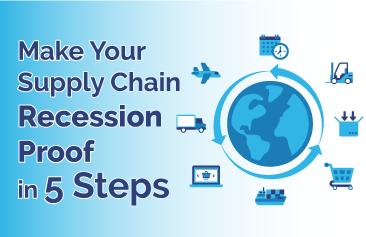The Hidden Cost of Delay: Why Waiting to Implement EDI Software Can Cost You More Than You Think

March 7, 2023
In a recent study, Gartner® found that 29% of supply chain leaders viewed technology as “critical to the success and growth of their business.” When it comes to the type of technology to implement, Gartner identifies “automation (i.e., supplementing, enhancing or replacing humans with things that can perform tasks independently), intelligence (i.e., leveraging technology to make better, faster and more enlightened decisions) and finally, resiliency (i.e., leveraging technologies to help address growing supply complexities).1″
Between increasingly complex global logistics, rapidly changing consumer behaviors, and ongoing labor constraints, you would think that companies would push for integration and automation implementation ASAP. And yet, many businesses are still holding back on implementing or upgrading their systems. Some worry about the short-term impact of large technology investments, especially when cash flow is limited.
For others, it’s the fear of disruption and workload strain. There’s enough going on in the market already—what if the implementation process interrupts key business activities? And if you’re working with an already lean team, the idea of adding in implementation management is daunting.
The hesitations are valid, but they’re also short-sighted. For one thing, if you choose an experienced provider with the right services, you can minimize disruptions without placing more burdens on your team. But even more importantly, the fear of spending on integrations might actually be costing you.
The Cost of In-House Management
Even if your business has existing systems like EDI, a less-than-seamless integration (or the use of non-integrated solutions) does more than hold back growth. The reality is that inefficiencies in your supply chain can create real expenses to your business right now.
Some solutions also require large investments in in-house management—especially those that use on-premises servers or require your business to map transactions yourself. In a market where 50% of businesses are cutting staff to manage other supply chain costs, you could end up with a team that can no longer keep up.
Sportsman’s Supply ran into that issue when they realized their chosen EDI provider was too slow to make changes or respond to their needs. Updating their catalogs took too long, and the brand’s ASN transactions were inconsistent—issues that were costing the company already.
By switching to a cloud-based, fully managed option from TrueCommerce, the brand was able to solve existing issues and find new efficiencies. Its team now spends less time on troubleshooting and enjoys greater transaction accuracy. According to a spokesperson, switching solutions was projected to “pay for itself in less than a year.”
Damaged Retailer Relationships
Another consequence of inefficient systems could be longer non-compliance issues. For example, if you’re utilizing a legacy EDI system, you may not have automatically updated trading partner maps. Leading retailers make changes to their EDI requirements regularly, and if your transactions are in the wrong format, or have missing or incorrect information, you may incur significant penalties. Walmart, for instance, charges $200 per non-compliant purchase order, plus $1 for every line item on the order.
You may also be working with retailers that score their vendors on their fulfillment times. For example, Amazon requires all Amazon Prime vendors in their Seller-Fulfilled Prime program to send orders out on the same day they’re received. They also need to achieve a 99% on-time delivery rate.
Amazon supplier Pearhead couldn’t enter the program because their existing fulfillment processes were too slow and required too much human intervention. The brand implemented integrated EDI to shorten lead times and was almost immediately able to meet Amazon’s stringent requirements. What’s more, the brand was able to increase their Amazon ASN score by 98%.
Not only can inefficient supply chain processes impact your eligibility for key retailer programs or result in chargebacks to your business. These issues can irreparably damage your retailer relationships, making your buyers less likely to expand their partnerships with you, and even driving them towards your competition.
In contrast, having seamless, real-time communication can strengthen trade relationships. As a representative from Pearhead put it, “For big retailers like Walmart, Bed Bath & Beyond and Amazon, everything is a scorecard. Thanks to EDI integration, our scorecards have improved across the board.”
Losing Your Competitive Advantage
As the Gartner report stated, “Supply chain leaders often cite technology as a key source of competitive advantage.”1 That sentiment is echoed by research from SAP, which found that 74% of business leaders are planning to adopt new supply chain technology in 2023.
What makes technology such a differentiator is the ability to make real-time decisions across procurement, manufacturing, inventory management, and other critical pieces of your supply chain. For example, cloud-based integrations can greatly increase supply chain visibility by providing insights into product movements and demand trends. This data can help your business avoid costly pitfalls like the bullwhip effect. It offers better traceability to mitigate the effects of recalls and other disruptions. It can also help you protect key trade relationships by providing better awareness of inventory availability for strategic allocation.
According to Gartner, “Almost half of respondents said that network complexity is their top external challenge and they need to identify technologies that can support their needs for agility and resilience.”1 Similarly, the report indicated that “Decision making speed and quality was also cited as a top internal challenge companies faced, motivating them to invest in technologies that can improve decision making.” With the right technology in place, you can make better decisions more quickly to create a more agile, resilient supply chain that keeps your business ahead of the competition.
Reduced Supply Chain ROI
Choosing to accelerate, rather than delay your EDI integration, doesn’t just keep your business competitive. It can also positively impact your business’s growth and profitability in the future.
When you invest in new technology, ROI is always a top consideration. But like customer lifetime value, your overall ROI is dependent on when you get started. For apparel manufacturer Trau & Loevner, switching to EDI not only helped eliminate existing costs; it also enabled greater flexibility during a global pandemic. At first, the brand experienced numerous cancellations from brick-and-mortar retailers; at the same time, Amazon eCommerce sales skyrocketed. Because of their EDI integration, Traun & Loevner was able to process the cancellations and reallocate that inventory for Amazon orders with barely a hitch.
When retail locations reopened, even more orders poured in. According to Production Coordinator, Ken Schnur, “Everyone was opening their stores at the same time, and they needed products to put on the shelves. We got absolutely slammed with orders. EDI made it possible to process them all.”
Because Trau & Loevner invested early in integration, they were prepared to manage unforeseen supply chain disruptions, while at the same time eliminating preventable costs. The long-term impact of that decision increased its overall ROI and continues to do so.
Jumpstart EDI Integration to Position Your Brand for Success
The downsides to putting off EDI implementation are clear, but that might not be enough to eliminate your worries about the time and effort needed for the implementation process. That fear could be even greater if you’ve been burned by setbacks before, either by trying to manage it internally, or relying on a partner who failed to deliver. To get your new EDI integration off the ground while minimizing the risks, consider the following:
- Protect your business from security risks. BSI Group found that in 73% of businesses, the Chief Risk Officer is “significantly concerned about the risks posed by the digitization of supply chain.” Data security is a critical concern for many, which is why it’s important to only look at vendors that prioritize best-in-class InfoSec practices. These may include SOC 2 Type II reports, GDPR compliance, user authentication, data encryption, and other techniques.
- Think about the future. While delaying your EDI investment could cost your business long-term value, so could implementing the wrong solution. For example, choosing an on-premises option when ERPs and other systems are mainly in the cloud could leave you with obsolete technology that needs to be swapped out in a few years. Selecting a vendor that only works with one ERP system could force you to re-implement a new integration if you ever upgrade or switch systems. Since you’re already thinking long-term, make sure to choose an integration partner who is built to scale with you even as your business needs change over the years.
- Make a plan. One easy way to circumvent speed bumps and setbacks is to select an integration provider with a proven implementation process. Once you’ve signed on, a partner with extensive experience will have a team already in place to handle the next steps; this will also take some stress off your team. Since building an integration from scratch can lengthen your onboarding process, prioritize vendors with pre-built, certified integrations for your existing ERP and other business systems.
Get Complete, End-to-End Integration from TrueCommerce
Integrating and automating your supply chain might be daunting, but the impact makes it worth the effort. By implementing ERP integration solutions, our customers have seen benefits like:
- Tripling the order volumes managed via automation — New Sega Home Textiles
- Reducing EDI costs by 75% in the first year — Leatherman Tools Group
- Processing document batches in 15-20 seconds — Oppenheimer
- Shortening Days Receivable Outstanding from 36 to 23 days — Vital Farms
As Chad Coffman, director of business systems and IT at Cali Bamboo, put it, “[TrueCommerce] EDI is supporting the whole company. It’s enabling us to continue to grow and still maintain on-time SLAs with our strategic customers and partners. And it’s freeing us up to focus strategically on additional relationships that will allow even stronger growth in coming years.”
To learn more about our offerings or get started with your EDI implementation so you can start experiencing greater supply chain ROI, contact us today.
1Gartner, Predicts 2023: Supply Chain Technology, Dwight Klappich, Christian Titze, Tim Payne, Amber Salley, Simon Tunstall, 28 November 2022
Gartner is registered trademark and servicemark of Gartner, Inc and/or its affiliates in the U.S. and internationally, and is used herein with permission. All rights reserved.
Share this post:
Categories
Stay ahead of the competition
Get expert supply chain insights delivered directly to your inbox weekly.

